 |
|
"Dopo cinque anni di assenza sono tornato in Alaska, la ragione principale per cui mi spingo fino a queste latitudini è sicuramente la possibilità di ammirare delle bellezze paesaggistiche uniche, posso candidamente affermare che l'Alaska è uno dei posti in assoluto che prediligo, un ulteriore motivo è anche la possibilità di fotografare aerei in un contesto scenografico altrettanto da mozzafiato. Durante la permanenza del 2007 ho raccolto del materiale che mi ha permesso di comporre un report fotografico che potete vedere cliccando: Alaska the last frontier. Questa volta invece con l'amico Giorgio abbiamo preferito redigere un articolo dedicato esclusivamente all’Aeroporto Internazionale di Anchorage."
Se si avesse a disposizione una sola parola con cui descrivere l'Alaska, la più appropriata sarebbe "GRANDE".
E' infatti questo l'aggettivo che meglio rende l'idea per definire il 49° stato dell'Unione che dall'ormai lontano 3 gennaio 1959 a pieno titolo fa parte integrante degli Stati Uniti.
Grandi sono ovviamente le dimensioni; con 586.878 miglia quadrate (1.522.596 kmq) l'Alaska rappresenta circa un quinto dell'intero territorio degli Stati Uniti. Per meglio rendere l'idea è opportuno sottolineare che è ben cinque volte più estesa dell'Italia.
Al suo interno troviamo la più alta montagna del continente nord americano, il Mount McKinley (6.178 m.), tremila corsi d'acqua e tre milioni di laghi, più di cinquemila ghiacciai (uno dei quali coprirebbe per estensione l'intero stato di Rhode Island). Per tre quarti circondata dal mare l'Alaska, isole comprese, ha oltre 75.000 km. di coste, più di tutto il resto degli Stati Uniti.
La rete stradale è molto limitata e copre solo una piccola parte del territorio, pertanto il mezzo di trasporto più diffuso è per forza di cose l'aereo; lo sviluppo economico dello stato è andato quindi di pari passo con i progressi dell'aeronautica.
Il primo aeroplano arrivò in Alaska nel lontano 1913. Grazie al contributo di innumerevoli pionieri che col loro coraggio e spesso con la vita qui furono scritte pagine memorabili della storia dell'aviazione. Fu però la Seconda Guerra Mondiale a dare un impulso significativo alla regione poiché a causa della sua importanza strategica vennero realizzati una serie di aeroporti che in seguito divennero fondamentali per favorire gli insediamenti.
E fu proprio grazie ai suoi due aeroporti, il Merrill Field e la base USAF (United States Air Force) di Elmendorf che la città di Anchorage, uno dei tanti piccoli centri abitati insediati da coraggiosi pionieri, prosperò sino a diventare il centro nevralgico dell'economia dello stato.
Pur non essendone la capitale politica, Anchorage ospita oggi circa la metà del poco più del mezzo milione degli abitanti dell'Alaska.
Un altro fattore contribuì a far si che qui si venne a realizzare quello che oggi a pieno titolo va annoverato fra i più importanti aeroporti del mondo.
Fin dal primissimo dopoguerra tutte le compagnie aeree, dapprima americane, poi europee ed infine asiatiche, si resero conto che la posizione di Anchorage era tale da risultare indispensabile per i collegamenti fra i tre continenti.
Ancora oggi la città si fregia del titolo di "Air Crossroads of the World", il crocevia aereo mondiale, essendo in pratica equidistante da Europa, Giappone e costa Est degli Usa. Tokyo dista 3.434 miglia, New York 3.365 e Londra 4.496.
|
|
|
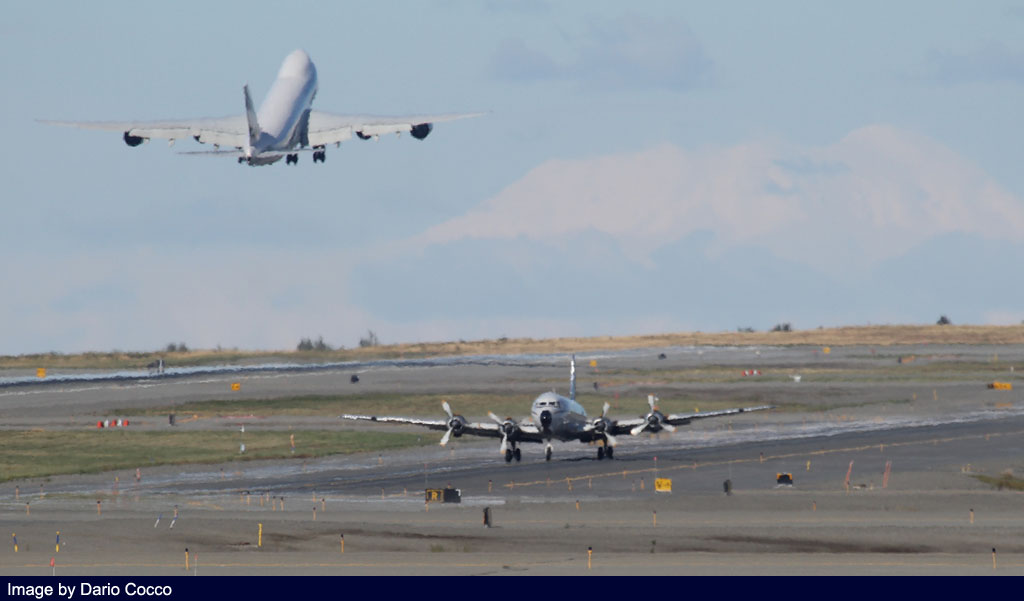 |
|
|
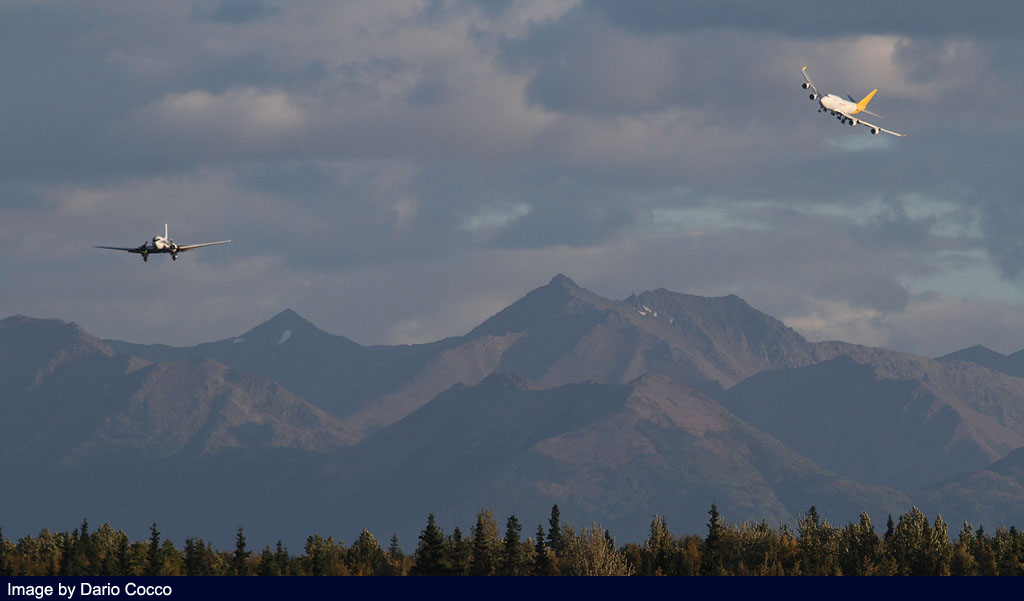 |
|
|
La Northwest Orient Airlines lanciò nel 1947 il primo servizio USA - Giappone via Anchorage seguita poi da SAS, Air France, KLM e Japan Air Lines.
Ben presto si capì che il Merrill Field non poteva assorbire tale tipo di traffico e già nel 1951 venne inaugurato il primo nucleo di quello che sarebbe diventato il nuovo aeroporto internazionale (codice IATA ANC, ICAO PANC) su un'area pianeggiante a circa tre miglia a sudovest del centro cittadino.
Col progredire della tecnologia aeronautica e l'avvento del jet si procedette all'allungamento della pista sufficienti per accogliere i primi DC 8 e B 707.
Il traffico continuò a crescere a ritmi molto sostenuti. Un grosso impulso lo diedero le attività petrolifere con la scoperta dei nuovi giacimenti del North Slope e l'escalation della guerra del Vietnam. Anchorage divenne scalo tecnico obbligato per il ponte aereo di uomini e mezzi diretti nel Sud-Est Asiatico.
L'aeroporto sopravvisse, pur con gravi danni, al famoso terremoto del 1964, uno dei più violenti del secolo (8.4 gradi della scala Richter) e verso la fine del decennio si rese necessario costruire una seconda pista parallela alla prima lunga 3.321 metri, completata nel 1970 in tempo per accogliere i primi Boeing B 747 della Pan Am.
Una terza pista nord-sud, perpendicolare alle altre due e quasi indispensabile in caso di vento traverso, rimase per molti anni allo stato di progetto in quanto presentava la difficoltà di conflitto con l'intenso traffico militare generato dalla base di Elmendorf distante poche miglia.
Finalmente nel 1980 la terza pista divenne realtà. Lunga 3.531 metri viene normalmente utilizzata per i decolli, in quanto ancor oggi il conflitto di traffico con Elemendorf esiste. E' prassi normale vedere un wide-body in attesa sulla testata 32 mentre una coppia di F 22, oppure un AWACS attraversano l'orizzonte in lungo finale per la base. Dopo il decollo è prevista una stretta virata sul mare ad una quota di 400 ft. con salita immediata a 6.000 ft..
Oggigiorno Anchorage non ha più l'importanza di un tempo come crocevia dei cieli tra Occidente ed Oriente in quanto l'apertura ai sorvoli degli spazi aerei sovietici a partire dal 1988 ha consentito più brevi rotte transiberiane. Inoltre l'arrivo dell'ultima generazione di wide-bodies a lunghissima autonomia come il B 747-8I o gli A 340 ha reso superfluo lo scalo in Alaska per molte compagnie.
Ma se ciò è vero per i voli passeggeri, non è così per quelli all-cargo, i quali privilegiando il carico pagante a discapito del carburante, non hanno il range sufficiente per un balzo non-stop.
E' proprio in questo settore che l'aeroporto di Anchorage ha trovato in questi ultimi anni la sua maggiore fonte di guadagno. Il fenomeno non è da sottovalutare se si considera che ANC è da anni saldamente in testa alla classifica sui pesi all'atterraggio dei voli all-cargo su aeroporti statunitensi.
A livello mondiale nel 2010 ANC è risultato il 5° più trafficato aeroporto del mondo per quanto riguarda il traffico merci, preceduto soltanto da Hong Kong, Memphis (hub del gigante FedEx), Shanghai e Seoul. |
|
|
|
|
|
|
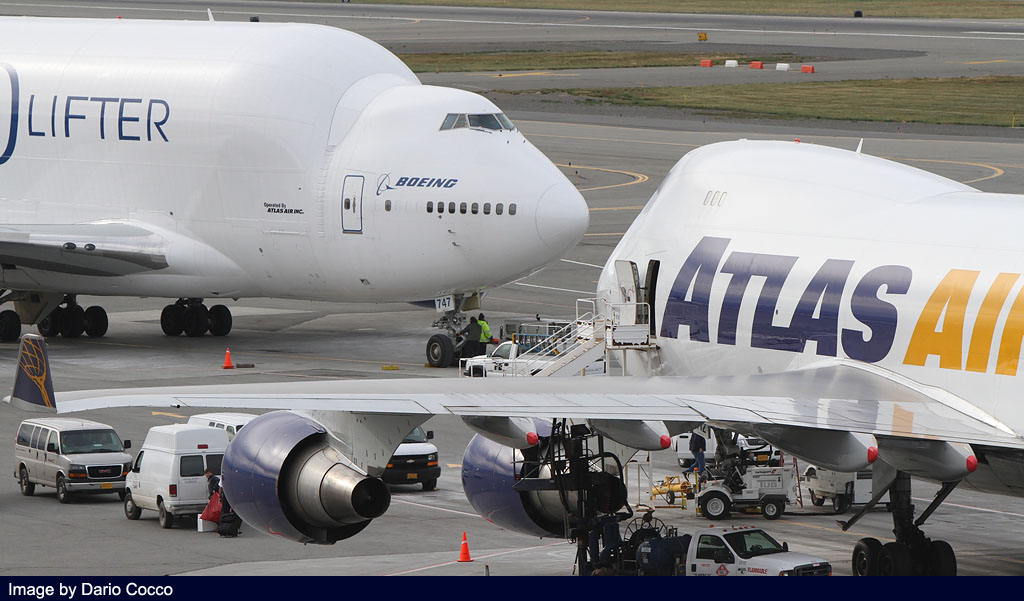 |
|
|
L'osservatore che si trovi a transitare in un giorno qualsiasi per il "Ted Stevens Anchorage International Airport", battezzato in onore dell'omonimo rappresentante al Senato dello stato dell'Alaska, è colpito soprattutto dalla presenza sul piazzale di decine di wide-bodies tuttomerci soprattutto asiatici parcheggiati fianco a fianco in attesa del rifornimento di carburante e cambio di equipaggio. Poichè gli orari del vari voli più o meno coincidono, i 747F e gli MD 11F arrivano e partono in strettissima sequenza soprattutto nelle ore centrali della giornata. Oltre trenta città europee, nord americane ed asiatiche sono collegate direttamente via ANC da servizi all-cargo. A conferma della vocazione all-cargo di questo scalo due colossi americani specializzati in trasporto merci, la FedEx Express e la UPS Airlines, hanno deciso di aprire ad Anchorage dei veri e propri hubs con tanto di hangars di manutenzione, rampe dedicate e magazzini per lo smistamento delle merci.
Ma l'aeroporto non vive solo di merci in transito. I servizi passeggeri, dopo gli anni del declino dovuto all'abbandono di ANC come scalo tecnico, si attestano su una media di 5 milioni di passeggeri. La parte del leone la fanno ovviamente i voli nazionali (sia all'interno dell'Alaska che con il resto degli USA), ma i voli internazionali sono in aumento soprattutto nei mesi estivi quando la gloriosa estate boreale attrae un sempre maggior numero di turisti. La tedesca Condor gestisce da anni con crescente successo l’unico collegamento diretto con l’Europa (Francoforte) che regolarmente registra il tutto esaurito. Sempre nei mesi estivi sono stati recentemente introdotti collegamenti diretti con l’estremo oriente sovietico.
In aggiunta vi sono poi gli operatori locali. La compagnia di casa à l'Alaska Airlines che con una moderna flotta di B 737 serve una ventina di destinazioni in Alaska oltre a parecchie altre a sud del 48° parallelo spingendosi lungo la costa del Pacifico a sud oltre Seattle sino alla California ed addirittura al Messico.
Penair, con una flotta di Saab 340 ed ERA Aviation dotata di Dash 8 sono i principali operatori regionali che assicurano frequenti collegamenti inter-state spingendosi sino all’estremità delle isole Aleutine.
Come già detto l'Alaska ha pochissime strade e la maggior parte degli insediamenti, anche se di poche anime, è collegata al resto del mondo solamente via aerea. Tutto il necessario alla vita del ventesimo secolo deve essere aviotrasportato su piste quasi sempre a fondo naturale, prive di radioassistenze e non particolarmente lunghe. Perciò se al trasporto dei pochi passeggeri bastano spesso aeroplani piccoli e rustici come i Navajo, i Cessna Caravan ed i Twin Otters, per le merci occorrono macchine più grandi.
Sono così nati ed hanno prosperato numerosi operatori tuttomerci. I principali sono: Northern Air Cargo, fino a qualche anno fa il più grande operatore mondiale di Dc 6, che recentemente si è convertito ai jet con una piccola flotta di B 737F; Everts Air Cargo che ancora opera con Dc 6 e C 46 Commando cui recentemente si è aggiunto un Dc 9; Lynden Air Cargo equipaggiata con L 100-30 Hercules. A questi si aggiungono numerosi operatori minori che volano con flotte piuttosto eterogenee che includono una gran varietà di modelli non facilmente visibili nei nostri aeroporti: Dhc 3 Otter, Casa 212, Dc 3, Skyvan sono parte del traffico di tutti giorni ad ANC ed è la norma vederli atterrare tra un wide-body e l’altro. |
|
|
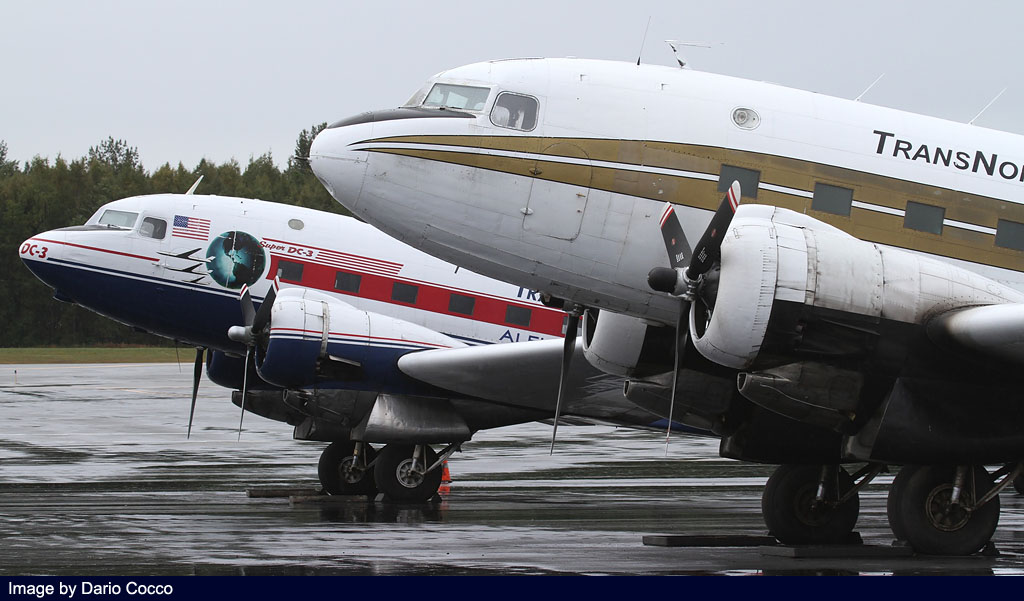 |
|
|
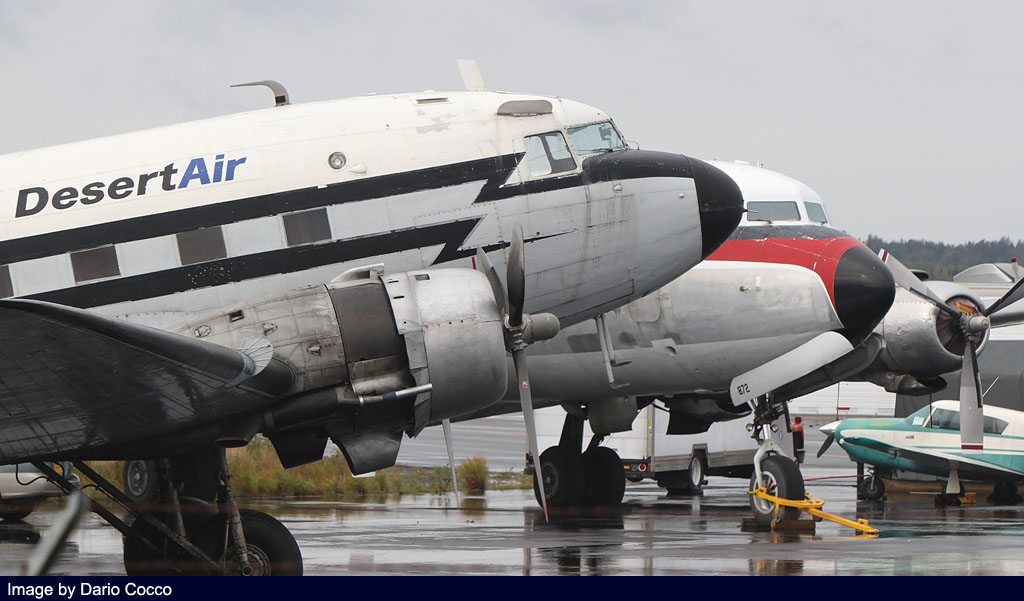 |
|
|
 |
|
|
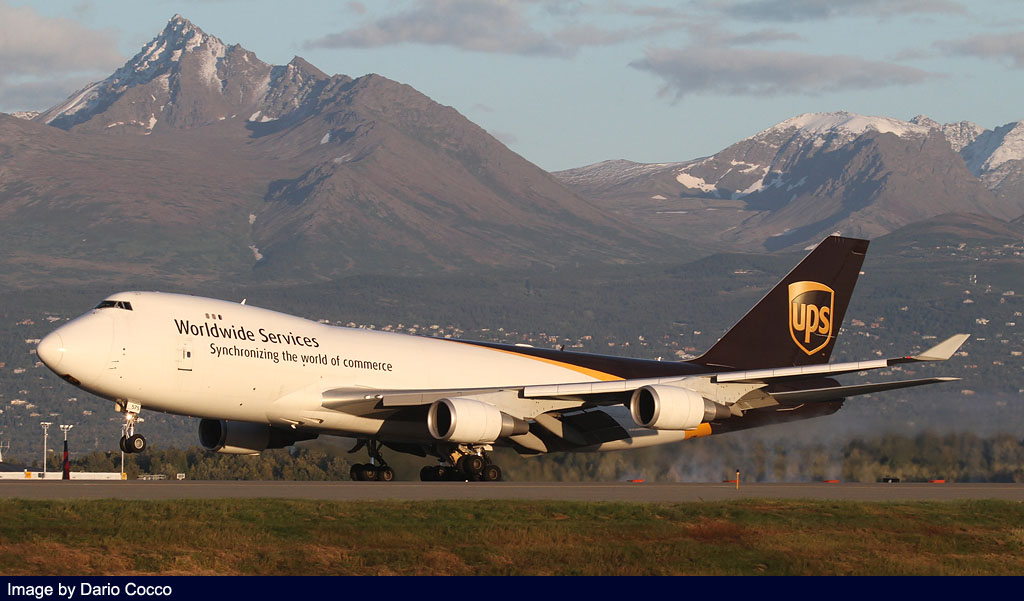 |
|
|
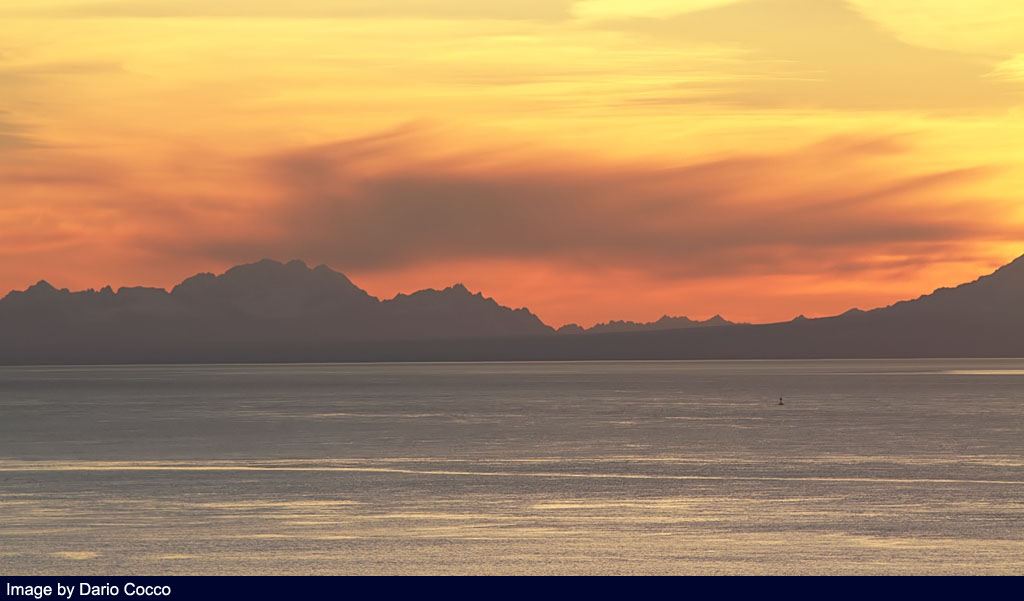 |
|
|
 |
|
|
 |
|
|
 |
|
|
L'angolo Sud-Est dell'aeroporto fino a qualche tempo fa occupato dai C 130 dell'Alaska Air National Guard è attualmente inutilizzato in quanto i militari hanno traslocato sulla vicina base di Elmendorf.
L'operatività dello scalo è garantita 24 ore al giorno 365 giorni all'anno. Cosa normale per un qualsiasi aeroporto intercontinentale; bisogna considerare però che la latitudine dell'Alaska è piuttosto elevata, pertanto i cambiamenti della condizioni meteo sono spesso imprevedibili. Nella stagione estiva le giornate sono "eterne". In giugno vi sono più 19 ore di luce e frequentemente il cielo è limpido e le temperature temperate. Spesso la visibilità è praticamente, illimitata, accade di avere bollettini meteo con "100 miglia" di visibilità e ciò è confermato dal fatto che spesso dall'aeroporto guardando verso Nord è possibile scorgere il profilo del Mt. McKinley distante 215 Km.. Ma l'altra faccia della medaglia è l'inverno. Anche in questo caso con tempo buono la visibilità è eccellente, ma le ore di luce in dicembre sono appena cinque. Una giornata serena può in pochi minuti diventare la peggiore con condimeteo estreme. Nebbia, nebbia ghiacciata, bufere di neve, temperature comunque polari, piste scivolose sono sempre da mettere in conto.
Un'altra peculiarità dell'Anchorage International è che all'interno del suo perimetro è compreso il famoso Lake Hood, il più grande e trafficato idroscalo del mondo (codice FAA LHD, ICAO PALH). Un canale artificiale che lo collega con l’adiacente Lake Spenard è utilizzato come “pista”. Grazie all’impianto di illuminazione ai bordi consente operazioni in VFR notturno. Sulle sponde di questo doppio lago in media sono ormeggiati 500 idrovolanti di vario tipo. I Beavers, gli Otters, i Cessna e i Pipers sono i più comuni ma l'appassionato può, esplorandone le rive, trovare delle vere e proprie rarità volanti. E se non ne ha abbastanza può anche fare una visitina all’Alaska Aviation Heritage Museum che esibisce una interessate collezione di aeroplani, dal relitto all'esemplare perfettamente restaurato; una completa testimonianza dello sviluppo aeronautico in questa terra di pionieri. Recentemente si è aggiunto un B 737-200 donato dall’Alaska Airlines.
Il Lake Hood negli ultimi anni ha avuto in media oltre 70.000 movimenti annui di idrovolanti, una cifra impressionante che farebbe invidia a molti scali di casa nostra ma comprensibilissima se si considera che, come detto nell'introduzione, in Alaska vi sono tre milioni di laghi che all'occorrenza possono diventare altrettanti aeroporti ...
A lato del Lake Hood vi è inoltre una piccola pista a fondo naturale lunga 600 metri per consentire il decollo agli oltre 400 aeroplani su ruote (sci d'inverno) dell'aviazione generale basati qui.
Se si considera che a poca distanza dall'aeroporto internazionale ancora funziona il vecchio scalo cittadino, il Merrill Field, oggi dedicato all'aviazione generale (oltre 900 aerei di base e 230.000 movimenti annui) si capisce come ad Anchorage l'aeronautica sia un'attività di primaria importanza.
Con la più elevata concentrazione di aeroplani pro-capite degli Stati Uniti e probabilmente del mondo, l'Alaska è indissolubilmente legata alle macchine volanti. Una visita a questa terra straordinaria è una grande avventura consigliabile a tutti. Per i patiti dell'aeronautica è un'occasione da non lasciarsi scappare e l'aeroporto di Anchorage in sé riassume molto bene lo spirito degli abitanti dell' "ultima frontiera".
Dopo un avvicinamento memorabile, con sorvolo di incredibili montagne tra ghiacciai e fiordi, si sbarca da un jet dell'ultima generazione; attraversati i confortevoli saloni del moderno terminal passeggeri si esce dall'altro lato approdando in pochi passi alle sponde del Lake Hood dove non è infrequente sorprendere un'alce che si abbevera. Qui un Beaver ti attende per portarti in una full immersion con la natura in una casetta di tronchi in riva ad un laghetto sperduto nel mezzo della wilderness ad anni luce da ogni forma di civiltà. |
|
|
 |
|
|
Foto e testo di Dario Cocco
Settembre 2012 |
|
English translation
"After five years of absence I returned to Alaska, the main reason why I’m going to these latitudes is definitely the chance to admire the beautiful unique scenery; I can candidly say that Alaska is one of my favorite places ever, another reason is also the opportunity to photograph planes in an equally spectacular and breathtaking scenery. During my stay back in 2007 I gathered material that allowed me to compose the photo report you can see by clicking: “Alaska the Last Frontier”. This time with my friend Giorgio we decided to publish an article devoted exclusively to Anchorage International Airport."
If you had just a single word to use to describe Alaska, the most appropriate would be "BIG".
And actually this is the word that best conveys the idea to define the 49th State of the Union that since January 3rd 1959 has become an integral part of the U.S..
Obviously the size is large, with 586,878 square miles (1,522,596 sq km) Alaska accounts for about a fifth of the entire U.S. territory. To better illustrate the idea it should be noted that it is five times larger than Italy.
Within Alaska we can find the highest mountain in the North American continent, Mount McKinley (6,178 m.), three thousand rivers and three million lakes, more than five thousand glaciers (one of which by extension would cover the entire state of Rhode Island). For three quarters surrounded by sea, Alaska, including the islands, has over 75,000 km. of coastline, most of the rest of the entire United States.
The road network is very limited and covers only a small part of the territory, so the most common means of transport is inevitably the plane; the economic development of the state is then gone hand in hand with the progress of aviation.
The first aircraft arrived in Alaska one century ago, in 1913. With the help of countless pioneers who, with their courage and often with their lives, many memorable pages in the history of aviation had been written here. But it was the Second World War to give a significant boost to the region; as a result of its strategic importance a number of airports were built and later became the key to facilitating settlements.
It was due to its two airports, Merrill Field, and the Elmendorf USAF base that the city of Anchorage, one of the many small towns settled by courageous pioneers prospered to become the nerve center of the State economy.
While not the political capital, Anchorage is now home to about half of the just over 500.000 inhabitants of Alaska.
Another factor helped to ensure that here was realized what now fully deserves to be counted among the most important airports in the world.
Early after Second World War all airlines, firstly American, then European and finally Asian, realized that the position of Anchorage was likely to be essential for the connections between the three continents.
Even today, the city boasts the title of "Air Crossroads of the World", being practically equidistant from Europe, Japan and the U.S. East Coast. Tokyo is 3.434 miles away, New York 3.365 and London 4.496.
Northwest Orient Airlines launched in 1947 the first USA-Japan service via Anchorage followed by SAS, Air France, KLM and Japan Air Lines.
Soon it was realized that Merrill Field could not cope with that kind of traffic and in 1951 the first nucleus of what would become the new international airport (IATA airport code ANC, ICAO PANC) on a flat area about 3 miles southwest of the city center was inaugurated.
With the progress of technology and the advent of jet aircraft the runway was stretched enough to welcome the first DC 8s and B 707s.
Traffic continued to grow at very robust rates. Oil activities with the discovery of new fields on the North Slope and the escalation of the Vietnam War gave the airport a big boost. Anchorage became a mandatory technical stop for the airlift of personnel and equipment South-East Asia bound.
The airport survived, albeit with serious damage, the famous earthquake of 1964, one of the most violent of the century (8.4 on the Richter scale), and towards the end of the decade it became necessary to build a second runway parallel to the first 3,321 meters long, completed in 1970 in time to receive the first Pan Am Boeing 747.
A third north-south runway, perpendicular to the other two and almost indispensable in case of crosswind, remanined for many years a project on the drawing boards as presented difficulties of conflict with the heavy military traffic generated by the Elmendorf base a few miles away.
Finally in 1980, the third runway became a reality. 3531 meters long is normally used for take-off, as even today the traffic conflict with Elemendorf exists. Is everyday occurrence to see a wide-body waiting on the threshold of runway 32 while a pair of F 22, or an AWACS cross the flightpath on long final for the base. After takeoff a sharp left turn on the sea at a height of 400 ft. with immediate climb to 6.000 ft. has to be performed.
Anchorage today no longer has the importance of past decades as a sky crossroads between East and West as the opening of Soviet airspace since 1988 has allowed shorter Trans-Siberian routes. In addition the arrival of the last generation of ultra long range wide-bodies as the B 747-800 or A 340 has rendered superfluous the Alaska stopover for many airlines.
But if this is true for passenger flights, it is not for freighters, which favoring the payload at the expense of fuel, do not have enough range for a non-stop hop.
In this sector Anchorage airport has found in recent years its main source of income. The phenomenon is not to be underestimated when you consider that ANC has long been firmly at the top of US airport list about the landing weights of all-cargo flights.
Globally ANC in 2010 was the 5th busiest airport in the world in terms of freight traffic, preceded only by Hong Kong, Memphis (hub of the giant FedEx), Shanghai and Seoul
The observer who happens to transit on any day through "Ted Stevens Anchorage International Airport", named in honor of the State of Alaska representative in the Senate, is mainly stricken by the presence on the aprons of dozens of heavy freighters mostly of Asian airlines parked side by side waiting for the fuel and change of crew. Since the schedules of the flights also more or less the same, the 747Fs and MD-11Fs arrive and depart in close sequence especially in the middle of the day. Over thirty cities in Europe, North America and Asia are directly connected with ANC by all-cargo services. To confirm the vocation of this mostly cargo airport two American giants specialized in package freight, FedEx Express and UPS Airlines, have decided to open in Anchorage their hubs with maintenance hangars, dedicated ramps and warehouses for sorting of goods.
But the airport is not only living on transit freight. Passenger services, after years of decline due to the abandonment of the ANC as an intermediate stop, show a yearly average of 5 million passengers. The lion's share is obviously made by domestic flights (both within Alaska and with the rest of the U.S.), but international flights are increasing especially in the summer months when the glorious northern summer attracts an increasing number of tourists. Condor from Germany is running with increasing success the only direct link to Europe (Frankfurt) who is regularly fully booked. Also during the summer months direct links to the Soviet Far East have been recently introduced.
In addition, there are also local operators. Alaska Airlines, the locally based major airline with a modern fleet of B737 is serving twenty destinations in Alaska as well as several more south of the 48th parallel stretching along the Pacific coast South from Seattle to California and even to Mexico.
Penair, with a fleet of Saab 340 and ERA Aviation equipped with Dash 8 are both key regional players that provide frequent inter-state connections reaching the end of the Aleutian Islands Chain.
As already mentioned Alaska has few roads and most of the settlements, even of a few people, are connected to the rest of the world only by air. Everything you need for everyday life of the twentieth century must be airlifted to short dirty runways, with no or basic radio aids. Therefore, if for the transport of the few passengers are often enough small and rustic airplanes like Navajos, Cessna Caravans and Twin Otters, transport of goods requires larger equipment.
Many cargo operators have been set up and thrived. The most important are: Northern Air Cargo, until a few years ago, the world's largest operator of DC-6, which has recently converted to jets with a small fleet of B 737F; Everts Air Cargo, which still operates piston equipment such as DC-6 and C-46 Commando recently supplemented by a DC-9; Lynden Air Cargo equipped with L100 Hercules. To these must be added a number of smaller operators who fly quite heterogeneous fleets that include a variety of models that are not easily visible in our airports: Otter, CASA 212, DC-3, Skyvan are part of the traffic all day and is no unusual in ANC see them landing between a wide-body and another.
The south-east corner of the airport until some time ago was occupied by the Alaska Air National Guard C-130 but is currently unused since the military moved to the nearby Elmendorf base.
The operation of the airport is provided 24 hours a day, 365 days a year. Normal thing for any international airport, you have to consider, however, that the latitude of Alaska is quite high, so the changes in the weather are often unpredictable. In summer the days are "eternal." In June, there are more than 19 hours of daylight and often the sky is clear and temperatures mild. Often visibility is virtually unlimited, happens to have weather reports with "100 miles" of visibility and this is confirmed by the fact that sometimes looking North from the airport you can spot the profile of Mt McKinley, 215 Km away. But the other face of the coin is the winter. Even in this case with good weather visibility is excellent, but the hours of light in December are barely 5. A clear day can turn in just a few minutes in the worst, with extreme meteo conditions. Fog, iced fog, blizzards, polar temperatures and slippery runways are always taken into account.
Another peculiarity is that the Anchorage International within its perimeter includes the famous Lake Hood, the largest and busiest seaplane base in the world (LHD FAA Code, ICAO PALH). An artificial channel that connects this basin with the adjacent Lake Spenard is used as a "runway." Thanks to the lighting system at the edges VFR night operations are allowed. On the shores of this twin lakes an average of 500 seaplanes of various kinds are moored. Beavers, Otters, Cessna and Pipers are the most common but the enthusiast can, exploring the shores, find flying rarities. And if you do not have enough of unusual airplanes you can also pay a visit to Alaska Aviation Heritage Museum, which exhibits an interesting collection of aircraft, from the wreck to perfectly restored exemlpary, a complete testimony of aviation development in this land of pioneers. Recently was added a B 737-200 donated by Alaska Airlines.
Lake Hood in recent years has had an average of more than 70,000 annual movements of seaplanes, an impressive figure that would be the envy of many airports in our country but understandable when you consider that, as mentioned in the introduction, in Alaska, there are 3 million lakes which can turn into as many airports...
On the eastern banks of Lake Hood there is also a 600 meters long gravel runway to allow the operation of the more than 400 general aviation aircraft on wheels (ski in winter) based here.
When you consider that just a short hop from the international airport still works the old downtown airport, Merrill Field, now dedicated to general aviation (over 900 based aircraft and and average of 230,000 movements per year) you understand why in Anchorage aviation is an activity of primary importance.
With the highest concentration of airplanes per capita in the United States and probably the World, Alaska is inextricably linked to the flying machines. A visit to this extraordinary land is a great adventure I suggest to everyone. For aeronautic enthusiasts is an opportunity not to miss and Anchorage airport itself summarizes very well the spirit of the inhabitants of the '"last frontier".
Following a memorable approach, with overflying of incredible mountains between glaciers and fjords, you disembark from a last generation jetliner, walk through the comfortable lounges of the modern passenger terminal and exit to the other side reaching within walking distance the shores of Lake Hood where is not uncommon to spot a moose drinking from the shores. Here, if you’re willing to, a Beaver is waiting to take you to a "full immersion" with the nature in a log house on the bank of a pond lost in the middle of the "wilderness", light years from any form of civilization.
|
Images and text by Dario Cocco
September 2012 |
|